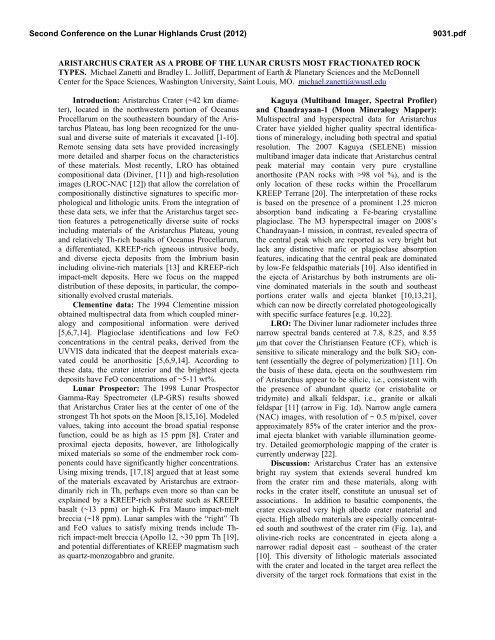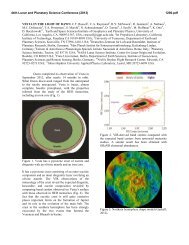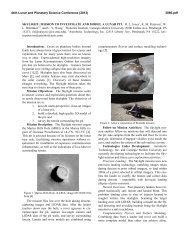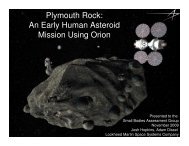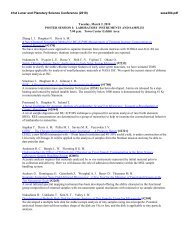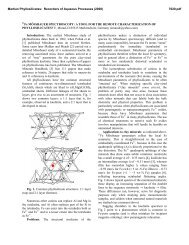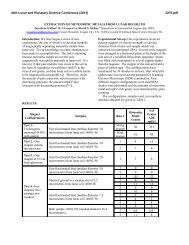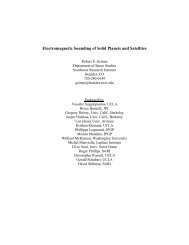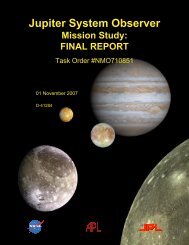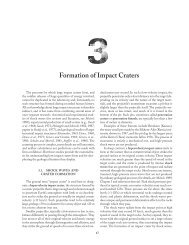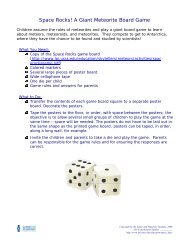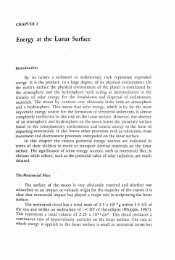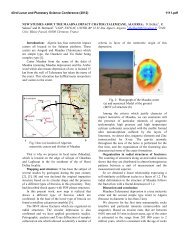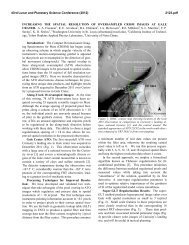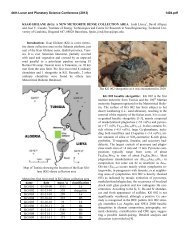Aristarchus Crater as a Probe of the Lunar Crust's Most Fractionated ...
Aristarchus Crater as a Probe of the Lunar Crust's Most Fractionated ...
Aristarchus Crater as a Probe of the Lunar Crust's Most Fractionated ...
You also want an ePaper? Increase the reach of your titles
YUMPU automatically turns print PDFs into web optimized ePapers that Google loves.
Second Conference on <strong>the</strong> <strong>Lunar</strong> Highlands Crust (2012)<br />
ARISTARCHUS CRATER AS A PROBE OF THE LUNAR CRUSTS MOST FRACTIONATED ROCK<br />
TYPES. Michael Zanetti and Bradley L. Jolliff, Department <strong>of</strong> Earth & Planetary Sciences and <strong>the</strong> McDonnell<br />
Center for <strong>the</strong> Space Sciences, W<strong>as</strong>hington University, Saint Louis, MO. michael.zanetti@wustl.edu<br />
Introduction: <strong>Aristarchus</strong> <strong>Crater</strong> (~42 km diameter),<br />
located in <strong>the</strong> northwestern portion <strong>of</strong> Oceanus<br />
Procellarum on <strong>the</strong> sou<strong>the</strong><strong>as</strong>tern boundary <strong>of</strong> <strong>the</strong> <strong>Aristarchus</strong><br />
Plateau, h<strong>as</strong> long been recognized for <strong>the</strong> unusual<br />
and diverse suite <strong>of</strong> materials it excavated [1-10].<br />
Remote sensing data sets have provided incre<strong>as</strong>ingly<br />
more detailed and sharper focus on <strong>the</strong> characteristics<br />
<strong>of</strong> <strong>the</strong>se materials. <strong>Most</strong> recently, LRO h<strong>as</strong> obtained<br />
compositional data (Diviner, [11]) and high-resolution<br />
images (LROC-NAC [12]) that allow <strong>the</strong> correlation <strong>of</strong><br />
compositionally distinctive signatures to specific morphological<br />
and lithologic units. From <strong>the</strong> integration <strong>of</strong><br />
<strong>the</strong>se data sets, we infer that <strong>the</strong> <strong>Aristarchus</strong> target section<br />
features a petrogenetically diverse suite <strong>of</strong> rocks<br />
including materials <strong>of</strong> <strong>the</strong> <strong>Aristarchus</strong> Plateau, young<br />
and relatively Th-rich b<strong>as</strong>alts <strong>of</strong> Oceanus Procellarum,<br />
a differentiated, KREEP-rich igneous intrusive body,<br />
and diverse ejecta deposits from <strong>the</strong> Imbrium b<strong>as</strong>in<br />
including olivine-rich materials [13] and KREEP-rich<br />
impact-melt deposits. Here we focus on <strong>the</strong> mapped<br />
distribution <strong>of</strong> <strong>the</strong>se deposits, in particular, <strong>the</strong> compositionally<br />
evolved crustal materials.<br />
Clementine data: The 1994 Clementine mission<br />
obtained multispectral data from which coupled mineralogy<br />
and compositional information were derived<br />
[5,6,7,14]. Plagiocl<strong>as</strong>e identifications and low FeO<br />
concentrations in <strong>the</strong> central peaks, derived from <strong>the</strong><br />
UVVIS data indicated that <strong>the</strong> deepest materials excavated<br />
could be anorthositic [5,6,9,14]. According to<br />
<strong>the</strong>se data, <strong>the</strong> crater interior and <strong>the</strong> brightest ejecta<br />
deposits have FeO concentrations <strong>of</strong> ~5-11 wt%.<br />
<strong>Lunar</strong> Prospector: The 1998 <strong>Lunar</strong> Prospector<br />
Gamma-Ray Spectrometer (LP-GRS) results showed<br />
that <strong>Aristarchus</strong> <strong>Crater</strong> lies at <strong>the</strong> center <strong>of</strong> one <strong>of</strong> <strong>the</strong><br />
strongest Th hot spots on <strong>the</strong> Moon [8,15,16]. Modeled<br />
values, taking into account <strong>the</strong> broad spatial response<br />
function, could be <strong>as</strong> high <strong>as</strong> 15 ppm [8]. <strong>Crater</strong> and<br />
proximal ejecta deposits, however, are lithologically<br />
mixed materials so some <strong>of</strong> <strong>the</strong> endmember rock components<br />
could have significantly higher concentrations.<br />
Using mixing trends, [17,18] argued that at le<strong>as</strong>t some<br />
<strong>of</strong> <strong>the</strong> materials excavated by <strong>Aristarchus</strong> are extraordinarily<br />
rich in Th, perhaps even more so than can be<br />
explained by a KREEP-rich substrate such <strong>as</strong> KREEP<br />
b<strong>as</strong>alt (~13 ppm) or high-K Fra Mauro impact-melt<br />
breccia (~18 ppm). <strong>Lunar</strong> samples with <strong>the</strong> “right” Th<br />
and FeO values to satisfy mixing trends include Thrich<br />
impact-melt breccia (Apollo 12, ~30 ppm Th [19],<br />
and potential differentiates <strong>of</strong> KREEP magmatism such<br />
<strong>as</strong> quartz-monzogabbro and granite.<br />
Kaguya (Multiband Imager, Spectral Pr<strong>of</strong>iler)<br />
and Chandrayaan-1 (Moon Mineralogy Mapper):<br />
Multispectral and hyperspectral data for <strong>Aristarchus</strong><br />
<strong>Crater</strong> have yielded higher quality spectral identifications<br />
<strong>of</strong> mineralogy, including both spectral and spatial<br />
resolution. The 2007 Kaguya (SELENE) mission<br />
multiband imager data indicate that <strong>Aristarchus</strong> central<br />
peak material may contain very pure crystalline<br />
anorthosite (PAN rocks with >98 vol %), and is <strong>the</strong><br />
only location <strong>of</strong> <strong>the</strong>se rocks within <strong>the</strong> Procellarum<br />
KREEP Terrane [20]. The interpretation <strong>of</strong> <strong>the</strong>se rocks<br />
is b<strong>as</strong>ed on <strong>the</strong> presence <strong>of</strong> a prominent 1.25 micron<br />
absorption band indicating a Fe-bearing crystalline<br />
plagiocl<strong>as</strong>e. The M3 hyperspectral imager on 2008’s<br />
Chandrayaan-1 mission, in contr<strong>as</strong>t, revealed spectra <strong>of</strong><br />
<strong>the</strong> central peak which are reported <strong>as</strong> very bright but<br />
lack any distinctive mafic or plagiocl<strong>as</strong>e absorption<br />
features, indicating that <strong>the</strong> central peak are dominated<br />
by low-Fe feldspathic materials [10]. Also identified in<br />
<strong>the</strong> ejecta <strong>of</strong> <strong>Aristarchus</strong> by both instruments are olivine<br />
dominated materials in <strong>the</strong> south and sou<strong>the</strong><strong>as</strong>t<br />
portions crater walls and ejecta blanket [10,13,21],<br />
which can now be directly correlated photogeologically<br />
with specific surface features [e.g. 10,22].<br />
LRO: The Diviner lunar radiometer includes three<br />
narrow spectral bands centered at 7.8, 8.25, and 8.55<br />
μm that cover <strong>the</strong> Christiansen Feature (CF), which is<br />
sensitive to silicate mineralogy and <strong>the</strong> bulk SiO2 content<br />
(essentially <strong>the</strong> degree <strong>of</strong> polymerization) [11]. On<br />
<strong>the</strong> b<strong>as</strong>is <strong>of</strong> <strong>the</strong>se data, ejecta on <strong>the</strong> southwestern rim<br />
<strong>of</strong> <strong>Aristarchus</strong> appear to be silicic, i.e., consistent with<br />
<strong>the</strong> presence <strong>of</strong> abundant quartz (or cristobalite or<br />
tridymite) and alkali feldspar, i.e., granite or alkali<br />
feldspar [11] (arrow in Fig. 1d). Narrow angle camera<br />
(NAC) images, with resolution <strong>of</strong> ~ 0.5 m/pixel, cover<br />
approximately 85% <strong>of</strong> <strong>the</strong> crater interior and <strong>the</strong> proximal<br />
ejecta blanket with variable illumination geometry.<br />
Detailed geomorphologic mapping <strong>of</strong> <strong>the</strong> crater is<br />
currently underway [22].<br />
Discussion: <strong>Aristarchus</strong> <strong>Crater</strong> h<strong>as</strong> an extensive<br />
bright ray system that extends several hundred km<br />
from <strong>the</strong> crater rim and <strong>the</strong>se materials, along with<br />
rocks in <strong>the</strong> crater itself, constitute an unusual set <strong>of</strong><br />
<strong>as</strong>sociations. In addition to b<strong>as</strong>altic components, <strong>the</strong><br />
crater excavated very high albedo crater material and<br />
ejecta. High albedo materials are especially concentrated<br />
south and southwest <strong>of</strong> <strong>the</strong> crater rim (Fig. 1a), and<br />
olivine-rich rocks are concentrated in ejecta along a<br />
narrower radial deposit e<strong>as</strong>t – sou<strong>the</strong><strong>as</strong>t <strong>of</strong> <strong>the</strong> crater<br />
[10]. This diversity <strong>of</strong> lithologic materials <strong>as</strong>sociated<br />
with <strong>the</strong> crater and located in <strong>the</strong> target area reflect <strong>the</strong><br />
diversity <strong>of</strong> <strong>the</strong> target rock formations that exist in <strong>the</strong><br />
9031.pdf
Second Conference on <strong>the</strong> <strong>Lunar</strong> Highlands Crust (2012)<br />
upper few km in this region, and <strong>the</strong> specific target<br />
rocks may be highly localized. Fur<strong>the</strong>rmore, some <strong>of</strong><br />
<strong>the</strong> components are not e<strong>as</strong>ily relatable to specific<br />
morphologic units [10,22] and cannot be explained by<br />
any simple petrogenetic scenario. For example, compositionally<br />
evolved KREEP-rich rocks and olivine-rich<br />
rocks [13] are not expected toge<strong>the</strong>r, and we infer that<br />
<strong>the</strong>se may simply reflect juxtaposition <strong>of</strong> Imbrium<br />
ejecta deposits with evolved intrusive rocks <strong>of</strong> <strong>the</strong><br />
PKT. Possible origins <strong>of</strong> <strong>the</strong> olivine-rich material are<br />
discussed by [13]. The high albedo materials, including<br />
those within <strong>the</strong> crater and <strong>the</strong> SW ejecta unit are most<br />
likely low-FeO, alkali-rich differentiates <strong>of</strong> a KREEPrich,<br />
near-surface intrusive body and not primary<br />
anorthosite <strong>of</strong> <strong>the</strong> Moon’s early primary crust.<br />
Given <strong>the</strong> extensive volcanic activity that occurred<br />
in this region <strong>of</strong> <strong>the</strong> Moon, b<strong>as</strong>altic underplating, <strong>as</strong><br />
suggested by Hagerty et al. [23], <strong>of</strong> KREEP rich rocks,<br />
may have caused partial melting and intrusion <strong>of</strong> silicic<br />
magma (with a small degree <strong>of</strong> melting) or melting and<br />
injection <strong>of</strong> an evolved KREEP-rich magma such <strong>as</strong><br />
quartz monzogabbro to a shallow level in <strong>the</strong> <strong>Aristarchus</strong><br />
target section. <strong>Aristarchus</strong> occurs close to two<br />
o<strong>the</strong>r localities where evolved, silicic volcanics are<br />
indicated by compositional and morphological data, <strong>the</strong><br />
Mairan and Gruithuisen Domes [8,11,23], which may<br />
indicate that this w<strong>as</strong> a special or even unique petrologic<br />
province on <strong>the</strong> Moon.<br />
Acknowledgements: We gratefully acknowledge<br />
<strong>the</strong> LRO Project and <strong>the</strong> LROC Team for <strong>the</strong>ir work in<br />
collecting <strong>the</strong> data and for support <strong>of</strong> this research.<br />
References: [1] Guest (1973) GSA Bulletin 84. [2] Zisk et al.<br />
(1977) Moon 17. [3] Etchegaray-Ramirez et al. (1983). JGR<br />
88 supplement p A529-A543 [4] Guest & Spudis (1985)<br />
Geol. Magazine 144. [5] Lucey et al. (1986) JGR 91. [6]<br />
McEwen et al. (1994) Science 266. [7] Le Mouélic et al.<br />
(1999) GRL 26. [8] Hagerty et al. (2009) JGR 114. [9]<br />
Chevrel et al. (2009) Icarus 199. [10] Mustard et al. (2011)<br />
JGR 116. [11] Glotch et al. (2010) Science 329. [12] Robinson<br />
et al. (2010) Space Science Reviews, 150. [13] Wiseman<br />
et al. (2012) LPSC 43, Abs #2515. [14] Pinet et al. (1999)<br />
LPSC 30, Abs 1555. [15] Lawrence, D. et al. (2003) JGR<br />
108. [16] Lawrence, D. et al. (2007) GRL 34. [17] Jolliff<br />
(2004) LPSC 35, Abs #2032. [18] Zhang and Jolliff (2008)<br />
LPS 39, #2534. [19] Korotev et al. (2011). Geo Chem Acta<br />
76, 6 [20] Ohtake et al (2009) Nature, 461. [21] Yamamoto et<br />
al., (2010) Nat Geo, 3. [22] Zanetti et al. (2011) LPSC 42,<br />
Abs #2330. [23] Hagerty et al., 2006 JGR 111. [24] Scholten<br />
F. et al. (2012) JGR 117, E00H17.<br />
Figure 1: <strong>Aristarchus</strong> <strong>Crater</strong> situated on <strong>the</strong> SE edge <strong>of</strong> <strong>the</strong><br />
<strong>Aristarchus</strong> Plateau. A) LRO WAC image, 100 mpp mosaic,<br />
B) WAC derived stereo topography, GLD100 [24], C) Clementine<br />
UV-VIS-derived FeO, D) LRO Diviner data (modified<br />
from [11]).<br />
9031.pdf


